Agroforestry as a Biodiversity Conservation Tool in the Atlantic Forest? Motivations and Limitations for Small-Scale Farmers to Implement Agroforestry Systems in North-Eastern Brazil
Abstract
1. Introduction
1.1. Agroforestry for Biodiversity Conservation and Agricultural Production
1.2. The Role of Agroforests for the Protection of Emblematic Species in Southern Bahia
1.3. Aims
2. Materials and Methods
2.1. Farmer Questionnaires
Farmers that own a farm not bigger than 50 hectares, and work their farms with their own personal work and with the work of their family, with the eventual help of third parties, (also collectives where the area of the land per person is not bigger than 50 hectares), and at least 80% of the gross income of the farm has to come from activities related to agriculture, livestock or silviculture or from rural extractivism.
2.2. Description of Form and Development of the Surveys
2.3. Analysis of the Questionnaires
3. Results
3.1. Characteristics of the Two Groups of Farmers
3.2. Farmers Surveys: Animal Species Presence on Agroforestry Farms
3.3. Agroforestry Versus Conventional Agriculture—Motivations and Limitations for Small-Scale Farmers
4. Discussion
4.1. Influence of the Regional Distribution of the Farmers in the Results
4.2. Agroforestry as a Tool for Biodiversity Conservation
4.2.1. Species Presence and Conservation in Agroforests
4.2.2. Farmers’ Willingness to Support Biodiversity Conservation through Agroforestry
4.3. Agroforestry Versus Conventional Agriculture—Motivations and Limitations for Small-Scale Farmers
4.3.1. Comparing the Economics of Agroforestry Systems and Conventional Agriculture
4.3.2. Farmers’ Perceptions of Agroforestry and How to Increase Conventional Farmers’ Willingness for Agroforestry
5. Conclusions
Author Contributions
Funding
Acknowledgments
Conflicts of Interest
Appendix A. Questionnaire for Farmers Working with Agroforestry and Conventional Agriculture
- □
- Povos da Mata
- □
- INCAPER
- □
- Iracambi
- A)
- General information about the farm:
- Name of the owner: _____________________________________________
- Name of the farm: ______________________________________________
- Location (state and municipality): _____________________________________________________________
- Size of the farm (in ha): ____________________
- Area used for agricultural/agroforestry purposes in your farm (in ha): ________________
- How far is your farm to the next road (in meters or kms): _______________
- How far is your farm to the closest “primary or secondary forest” (in meters or kms) ________________________
- Do you have an area where you plant products for your own/family consumption?
- □
- Yes
- □
- No
- Mention the plant and animal species on your agricultural land (excluding the land you use for own consumption). In other words, mention the species/products you sell/use for commerce.(It can be that you work with just one or that you work with more species):
1. 2. 3. 4. 5. 6. 7. 8. 9. 10.
- B)
- Socio-environmental data:
- Do you consider your soil fertile?
- □
- yes
- □
- no
- Do you irrigate your land?
- □
- Yes
- □
- No
- Do you take or took part in any of the following support programs?
- □
- Technical assistance and rural extension
- □
- Capacitation/training for your current agricultural practice
- □
- I am part of an agricultural/agroecological organization, institution or support group
- C)
- Income per hectare in the last 3 years:
- What was approximately your monthly income per hectare in the last 3 years (in Brazilian reals) If you know the information just for some of the years you can write that down too:
Year Monthly Income Per Hectare 2017 2016 2015
- 1.
- Do you know of the existence of any of the following governmental programs that promote or can support the creation of agricultural or agroecological systems?If yes, please mark the programs that you are aware of.Programa Nacional de Alimentação Escolar—PNAE
- □
- Programa de Aquisição de Alimentos—PAA
- □
- PRONAF - Programa Nacional da Agricultura Familiar
- □
- Payment for ecosystem services—Atlantic Forest Law
- □
- Other governmental programs: __________________________________________
- 2.
- Do you take or took part in any of the following governmental programs?Please mark the programs you take or took part of.
- □
- Programa Nacional de Alimentação Escolar - PNAE
- □
- Programa de Aquisição de Alimentos - PAA
- □
- PRONAF - Programa Nacional da Agricultura Familiar
- □
- Payment for ecosystem services -Atlantic Forest Law
- □
- Other governmental programs: __________________________________________
- 3.
- Do some of the wild animals listed below come through or live on your land?If yes, please mark the animals that come through or live in your land.
- □
- Maned sloth (just for the farmers living in southern Bahia)
- □
- Golden-headed-lion tamarin (just for the farmers living in southern Bahia)
- □
- Golden-bellied capuchin (just for the farmers living in southern Bahia)
- □
- Other monkeys
- □
- Carnivores (such as oncilla, ocelot, crab-eating fox, and other carnivores)
- □
- Other large mammals (such as peccary, deer)
- □
- Rodents (such as mice, squirrel, bristle-spined rat and other rodents)
- □
- Bats
- 4.
- Do you accept/like having wild animals on your land (such as monkeys, small or large rodents, foxes, armadillos, and other small or large animals)?
- □
- Yes
- □
- No
- 4.1
- If your answer was yes, what are the reasons for you to accept/like having these wild animals in your land??
- □
- They can act as “regulators” on my land and thus avoid biological diseases/ making my system more resilient
- □
- Animals have a right to live here too
- □
- I can hunt them and use as food source
- □
- Other: ________________________________________________________
- 4.2
- If your answer was no, what are the reasons for you not to accept/like having these wild animals on your fields?
- □
- They can damage my crops/domesticated animals
- □
- They can damage my household and the items in it (such as food, pets, etc.)
- □
- They can bring pests and diseases to the land
- □
- Other: ________________________________________________________
- 5.
- What do you think/is your perception about intercropping woody perennials with your main agricultural crop?Please mark with an X, the answers that you agree with:
- □
- It can decrease the income and the production of the land in the short term
- □
- It can decrease the income and the production of the land in the long term
- □
- It can increase the income and the production of the land in the short term
- □
- It can increase the income and the production of the land in the long term
- □
- It can bring more pests and diseases to the system
- □
- It can attract natural enemies and regulate the microclimate, avoiding pests and diseases in the system
- □
- It can increase the quality and nutrients in the soils
- □
- It can make the system more resilient towards market changes
- □
- It is more complicated to sell/ make profits out of two or more different products
- □
- It can complicate my production system
- □
- I don’t have experience with it and I can be risking my income
- 6.
- What are the main reasons for you to work with agroforest systems compared to conventional/monoculture farming system? Which benefits do you get from practicing this land-use system?Please mark with an X the main reasons:
- □
- Higher income generation
- □
- The ability to sell the products at a higher unit price/price per kg (due to its organic origins, better quality of the products or different certification mechanisms)
- □
- Increases the land’s quality and productivity (water retention, improvement of the soils, use of different levels of production, microclimate regulation, etc.)
- □
- A system that can give you different products at different times of the year
- □
- More products and food for self sufficiency
- □
- Agricultural system that is more resilient to climatic, biological (diseases) or market impairs
- □
- It helps in conserving/increasing the biodiversity of flora and fauna in the region
- □
- Other important reasons: _______________________________________________
- 7.
- What are the disadvantages/most limiting factors when working with agroforest systems?Please mark with an X the main disadvantages/limiting factors:
- □
- The long time one has to wait to make profits out of the woody perennials
- □
- Reduction in yield of the main agricultural crop
- □
- The logistical difficulty of managing and harvesting two (or more) plant species in the same area
- □
- The difficulty to sell diverse products in the market
- □
- Uncertainty towards the rights to own the land in the long term
- □
- It attracts unwanted pests, insects, animals or other biological diseases
- □
- Other important disadvantages/limitations: ________________________________
- 8.
- If you could plant more woody perennials (such as trees, shrubs, palms, bamboos, etc.) in your field and thus potentially get benefits from this diversified agricultural system, but you would also be taking a risk in changing the dynamics of your land, would you consider implementing this kind of system?
- □
- Yes
- □
- No
- 8.1
- If your answer was yes, which benefits would you be expecting to get from your farm diversified with woody perennials (such as trees, shrubs, palms, bamboos, etc.)?Please mark with an X the main expected benefits:
- □
- Higher income generation
- □
- The ability to sell the products at a higher unit price/price per kg (due to its organic origins, better quality or different certification mechanisms)
- □
- Increases the land’s quality and productivity (water retention, improvement of the soils, use of different levels of production, microclimate regulation, etc.)
- □
- A system that can give you different products at different times of the year
- □
- More products and food for self sufficiency
- □
- Agricultural system that is more resilient to climatic, biological (diseases) or market impairs
- □
- It helps in conserving/increasing the biodiversity of flora and fauna in the region
- □
- Other important reasons: _______________________________________________
- 8.2
- If your answer was yes, what do you think are the main barriers for diversifying your farm with woody perennials?Please mark with an X the main barriers:
- □
- Uncertainty towards how the system might work/it might fail
- □
- Lack of successful models and knowledge in the region where I live to know how to make that transition
- □
- The long time one has to wait to make profits out of the woody perennials
- □
- Reduction in yield of the main agricultural crop
- □
- The logistical difficulty of managing and harvesting two (or more) plant species in the same area
- □
- The difficulty to sell diverse products in the market
- □
- Uncertainty towards the rights to own the land in the long term
- □
- It might attract unwanted pests, insects, animals or other biological diseases
- □
- Other important disadvantages/limitations: ________________________________
- 8.3
- If your answer was no, what are the main reasons why you would not like to implement woody perennials in your farm?
- □
- Please mark with an X the main reasons:
- □
- Uncertainty towards how the system might work/it might fail
- □
- Lack of successful models and knowledge in the region where I live to know how to make that transition
- □
- The long time one has to wait to make profits out of the woody perennials
- □
- Reduction in yield of the main agricultural crop
- □
- The logistical difficulty of managing and harvesting two (or more) plant species in the same area
- □
- The difficulty to sell diverse products in the market
- □
- Uncertainty towards the rights to own the land in the long term
- □
- It might attract unwanted pests, insects, animals or other biological diseases
- □
- Other important disadvantages/limitations: ________________________________
Appendix B. Location of the Farms and Farm Sizes
| Conventional Agriculture | ||||
|---|---|---|---|---|
| Farmer Number | State | Municipality | Size of the Farm (in ha) | Area Used for Agricultural Purposes (in ha) |
| Farmer 1 | southern Bahia | Ipiaú | 7 | 1 |
| Farmer 2 | southern Bahia | Itacaré | 3 | 1 |
| Farmer 3 | southern Bahia | Itacaré | 3 | 2 |
| Farmer 4 | Espírito Santo | Barra de São Francisco | 1 | 1 |
| Farmer 5 | Espírito Santo | Barra de São Francisco | 7 | 1 |
| Farmer 6 | Espírito Santo | Barra de São Francisco | 8 | 3 |
| Farmer 7 | Espírito Santo | Conceição da Barra | 12 | 6 |
| Farmer 8 | Espírito Santo | Pedro Canário | 9 | |
| Farmer 9 | Espírito Santo | Pedro Canário | 10 | |
| Farmer 10 | Espírito Santo | Pedro Canário | 10 | |
| Farmer 11 | Espírito Santo | Pedro Canário | 10 | 3 |
| Farmer 12 | Espírito Santo | Pedro Canário | 10 | 9 |
| Farmer 13 | Espírito Santo | Pedro Canário | 24 | |
| Farmer 14 | Espírito Santo | São Gabriel da Palha | 5 | 3 |
| Farmer 15 | Espírito Santo | São Gabriel da Palha | 24 | 12 |
| Farmer 16 | Espírito Santo | São Gabriel da Palha | 28 | 21 |
| Farmer 17 | Espírito Santo | São Gabriel da Palha | 34 | 18 |
| Farmer 18 | Espírito Santo | Vila Pavão | 8 | 4 |
| Farmer 19 | Espírito Santo | Vila Pavão | 26 | 15 |
| Farmer 20 | Espírito Santo | Vila Pavão | 34 | 27 |
| Farmer 21 | Espírito Santo | Vila Pavão | 45 | 22 |
| Farmer 22 | Minas Gerais | Rosário da Limeira | 1 | 1 |
| Farmer 23 | Minas Gerais | Rosário da Limeira | 3 | 3 |
| Farmer 24 | Minas Gerais | Rosário da Limeira | 4 | 4 |
| Farmer 25 | Minas Gerais | Rosário da Limeira | 5 | 4 |
| Farmer 26 | Minas Gerais | Rosário da Limeira | 9 | 7 |
| Farmer 27 | Minas Gerais | Rosário da Limeira | 12 | 3 |
| Farmer 28 | Minas Gerais | Rosário da Limeira | 15 | 15 |
| Farmer 29 | Minas Gerais | Antônio Prado de Minas | 26 | 24 |
| Farmer 30 | Minas Gerais | Espera Feliz | 2 | 1 |
| Farmer 31 | Minas Gerais | Eugenópolis | 19 | 9 |
| Farmer 32 | Minas Gerais | Eugenópolis | 22 | 18 |
| Farmer 33 | Minas Gerais | Eugenópolis | 24 | 19 |
| Farmer 34 | Minas Gerais | Eugenópolis | 29 | 3 |
| Farmer 35 | Minas Gerais | Eugenópolis | 48 | 33 |
| Farmer 36 | Minas Gerais | Laranjal | 24 | 20 |
| Farmer 37 | Minas Gerais | Laranjal | 25 | 22 |
| Farmer 38 | Minas Gerais | Laranjal | 35 | 30 |
| Farmer 39 | Minas Gerais | Leopoldina | 12 | 8 |
| Farmer 40 | Minas Gerais | Miradouro | 7 | 3 |
| Farmer 41 | Minas Gerais | Muriaé | 5 | 3 |
| Farmer 42 | Minas Gerais | Muriaé | 6 | 3 |
| Farmer 43 | Minas Gerais | Muriaé | 14 | 8 |
| Farmer 44 | Minas Gerais | Muriaé | 15 | 8 |
| Farmer 45 | Minas Gerais | Muriaé | 22 | 16 |
| Farmer 46 | Minas Gerais | Muriaé | 30 | 24 |
| Farmer 47 | Minas Gerais | Muriaé | 30 | 10 |
| Farmer 48 | Minas Gerais | Muriaé | 30 | 3 |
| Farmer 49 | Minas Gerais | Muriaé | 60 | 48 |
| Farmer 50 | Minas Gerais | Pedra Dourada | 2 | 2 |
| Farmer 51 | Minas Gerais | Pedra Dourada | 6 | 4 |
| Farmer 52 | Minas Gerais | Rosário da Limeira | 4 | 3 |
| Farmer 53 | Minas Gerais | Rosário da Limeira | 4 | 2 |
| Farmer 54 | Minas Gerais | Rosário da Limeira | 4 | 3 |
| Farmer 55 | Minas Gerais | Rosário da Limeira | 6 | 5 |
| Farmer 56 | Minas Gerais | Rosário da Limeira | 6 | 2 |
| Farmer 57 | Minas Gerais | Rosário da Limeira | 10 | 2 |
| Farmer 58 | Minas Gerais | Rosário da Limeira | 12 | 6 |
| Farmer 59 | Minas Gerais | Rosário da Limeira | 12 | 6 |
| Farmer 60 | Minas Gerais | Rosário da Limeira | 12 | 4 |
| Farmer 61 | Minas Gerais | Rosário da Limeira | 15 | 15 |
| Farmer 62 | Minas Gerais | Rosário da Limeira | 15 | 3 |
| Farmer 63 | Minas Gerais | Rosário da Limeira | 36 | 30 |
| Farmer 64 | Minas Gerais | Rosário da Limeira | 57 | 9 |
| Agroforestry | ||||
|---|---|---|---|---|
| Farmer Number | State | Municipality | Size of the Farm (in ha) | Area Used for Agricultural Purposes (in ha) |
| Farmer 1 | southern Bahia | Ilhéus | 12 | 7 |
| Farmer 2 | southern Bahia | Ilhéus | 12 | 8 |
| Farmer 3 | southern Bahia | Itacaré | 1 | 1 |
| Farmer 4 | southern Bahia | Itacaré | 2 | 1 |
| Farmer 5 | southern Bahia | Itacaré | 2 | 1 |
| Farmer 6 | southern Bahia | Itacaré | 3 | 2 |
| Farmer 7 | southern Bahia | Itacaré | 3 | 2 |
| Farmer 8 | southern Bahia | Itacaré | 3 | 2 |
| Farmer 9 | southern Bahia | Itacaré | 3 | 2 |
| Farmer 10 | southern Bahia | Itacaré | 3 | 2 |
| Farmer 11 | southern Bahia | Itacaré | 3 | 2 |
| Farmer 12 | southern Bahia | Itacaré | 4 | 3 |
| Farmer 13 | southern Bahia | Itacaré | 5 | 2 |
| Farmer 14 | southern Bahia | Itacaré | 5 | 3 |
| Farmer 15 | southern Bahia | Itacaré | 5 | 3 |
| Farmer 16 | southern Bahia | Itacaré | 5 | 4 |
| Farmer 17 | southern Bahia | Itacaré | 6 | 5 |
| Farmer 18 | southern Bahia | Itacaré | 7 | 3 |
| Farmer 19 | southern Bahia | Itacaré | 8 | 4 |
| Farmer 20 | southern Bahia | Itacaré | 8 | 6 |
| Farmer 21 | southern Bahia | Itacaré | 8 | 4 |
| Farmer 22 | southern Bahia | Itacaré | 9 | 4 |
| Farmer 23 | southern Bahia | Itacaré | 9 | 4 |
| Farmer 24 | southern Bahia | Itacaré | 10 | 8 |
| Farmer 25 | southern Bahia | Itacaré | 10 | 8 |
| Farmer 26 | southern Bahia | Itacaré | 10 | 8 |
| Farmer 27 | southern Bahia | Itacaré | 10 | 6 |
| Farmer 28 | southern Bahia | Itacaré | 10 | 3 |
| Farmer 29 | southern Bahia | Itacaré | 12 | 5 |
| Farmer 30 | southern Bahia | Itacaré | 13 | 3 |
| Farmer 31 | southern Bahia | Itacaré | 16 | 5 |
| Farmer 32 | southern Bahia | Itacaré | 17 | 10 |
| Farmer 33 | southern Bahia | Itacaré | 17 | 15 |
| Farmer 34 | southern Bahia | Itacaré | 18 | 9 |
| Farmer 35 | southern Bahia | Itacaré | 20 | 10 |
| Farmer 36 | southern Bahia | Itacaré | 22 | 3 |
| Farmer 37 | southern Bahia | Itacaré | 24 | 9 |
| Farmer 38 | southern Bahia | Itacaré | 26 | 13 |
| Farmer 39 | southern Bahia | Itacaré | 40 | 30 |
| Farmer 40 | southern Bahia | Maraú | 20 | 16 |
| Farmer 41 | southern Bahia | Uruçuca | 5 | 2 |
| Farmer 42 | southern Bahia | Uruçuca | 5 | 2 |
| Farmer 43 | southern Bahia | Uruçuca | 6 | 3 |
| Farmer 44 | Espírito Santo | Barra de São Francisco | 23 | 15 |
| Farmer 45 | Espírito Santo | Barra de São Francisco | 30 | 7 |
| Farmer 46 | Espírito Santo | Nova Venceia | 9 | 5 |
| Farmer 47 | Espírito Santo | Nova Venceia | 10 | 3 |
| Farmer 48 | Espírito Santo | Nova Venceia | 25 | 19 |
| Farmer 49 | Espírito Santo | Nova Venceia | 27 | 15 |
| Farmer 50 | Espírito Santo | Nova Venceia | 51 | 50 |
| Farmer 51 | Espírito Santo | Pedro Canário | 9 | 7 |
| Farmer 52 | Espírito Santo | São Gabriel da Palha | 4 | 2 |
| Farmer 53 | Minas Gerais | Miraí | 36 | 6 |
| Farmer 54 | Minas Gerais | Espera Feliz | 8 | 6 |
| Farmer 55 | Minas Gerais | Eugenópolis | 14 | 12 |
| Farmer 56 | Minas Gerais | Miradouro | 5 | 3 |
| Farmer 57 | Minas Gerais | Muriaé | 1 | 1 |
| Farmer 58 | Minas Gerais | Muriaé | 6 | 4 |
| Farmer 59 | Minas Gerais | Muriaé | 7 | 4 |
| Farmer 60 | Minas Gerais | Muriaé | 12 | 4 |
| Farmer 61 | Minas Gerais | Muriaé | 12 | 7 |
| Farmer 62 | Minas Gerais | Muriaé | 18 | 17 |
| Farmer 63 | Minas Gerais | Muriaé | 27 | 2 |
| Farmer 64 | Minas Gerais | Muriaé | 28 | 20 |
| Farmer 65 | Minas Gerais | Muriaé | 87 | 5 |
| Farmer 66 | Minas Gerais | Rosário da Limeira | 1 | 1 |
| Farmer 67 | Minas Gerais | Rosário da Limeira | 2 | 1 |
| Farmer 68 | Minas Gerais | Rosário da Limeira | 3 | 2 |
| Farmer 69 | Minas Gerais | Rosário da Limeira | 6 | 6 |
| Farmer 70 | Minas Gerais | Rosário da Limeira | 6 | 5 |
| Farmer 71 | Minas Gerais | Rosário da Limeira | 15 | 10 |
| Farmer 72 | Minas Gerais | Rosário da Limeira | 15 | 5 |
| Farmer 73 | Minas Gerais | Rosário da Limeira | 22 | 15 |
| Farmer 74 | Minas Gerais | São Francisco do Glória | 30 | 13 |
| Farmer 75 | Minas Gerais | São Francisco do Glória | 66 | 39 |
Appendix C. Benefits of Working with Agroforestry According to the Three Analyzed States
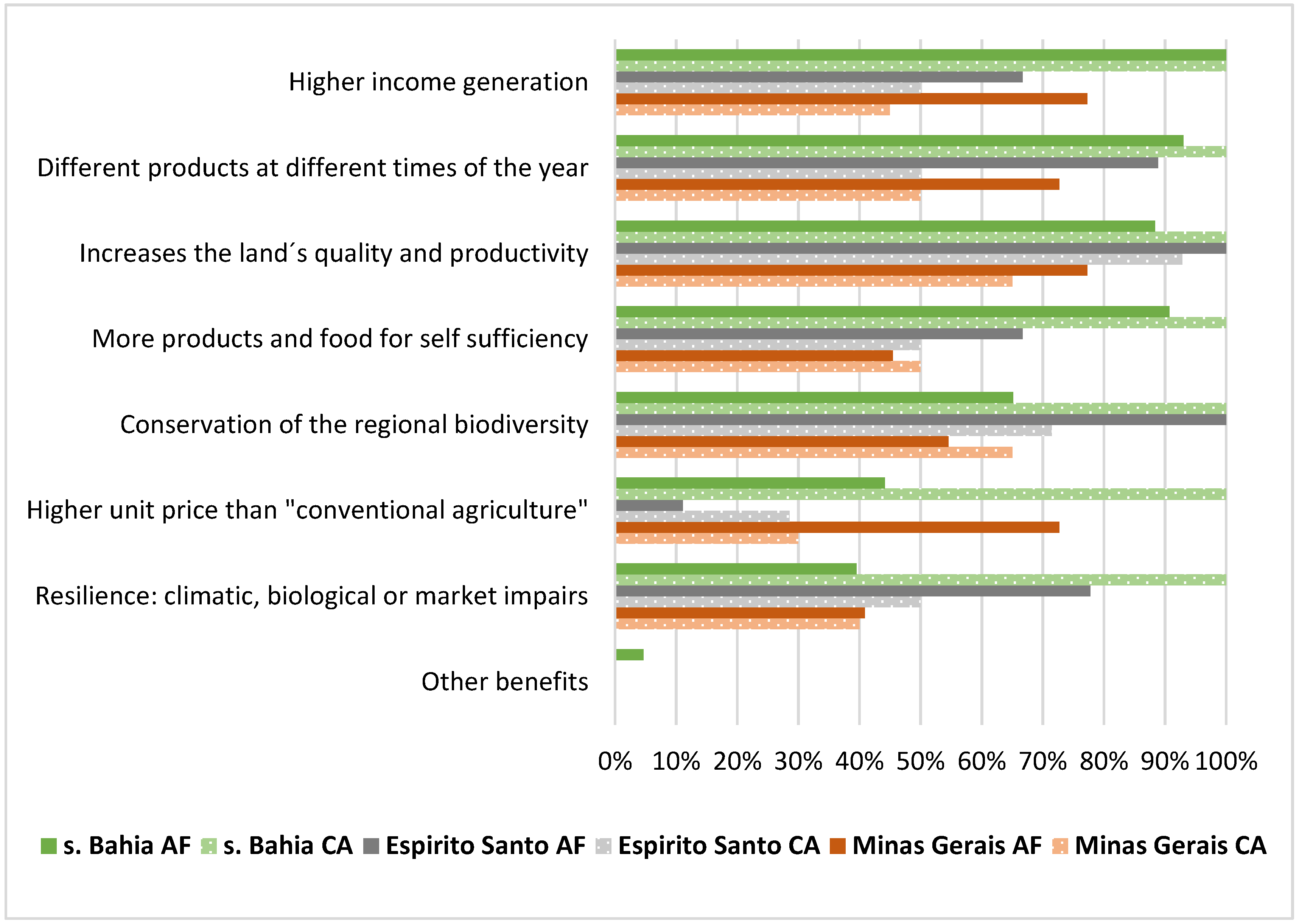
References
- Atangana, A.; Khasa, D.; Chang, S.; Degrande, A. Tropical Agroforestry; Springer: Dordrecht, The Netherlands, 2014. [Google Scholar]
- Nair, P.K. An Introduction to Agroforestry; Kluwer Academic Publishers: Dordrecht, The Netherlands, 1993. [Google Scholar]
- Tscharntke, T.; Milder, J.C.; Schroth, G.; Clough, Y.; DeClerck, F.; Waldron, A.; Rice, R.; Ghazoul, J. Conserving Biodiversity Through Certification of Tropical Agroforestry Crops at Local and Landscape Scales. Conserv. Lett. 2015, 8, 14–23. [Google Scholar] [CrossRef]
- Porro, R.; Miller, R.P.; Tito, M.R.; Donovan, J.A.; Vivan, J.L.; Trancoso, R.; Van Kanten, R.F.; Grijalva, J.E.; Ramirez, B.L.; Gonçalves, A.L. Agroforestry in the Amazon Region: A Pathway for Balancing Conservation and Development. In Agroforestry-The Future of Global Land Use; Nair, P.R., Garrity, D., Eds.; Springer: Dordrecht, The Netherlands, 2012; pp. 391–428. [Google Scholar]
- Zomer, R.J.; Neufeldt, H.; Xu, J.; Ahrends, A.; Bossio, D.; Trabucco, A.; Van Noordwijk, M.; Wang, M. Global Tree Cover and Biomass Carbon on Agricultural Land: The contribution of agroforestry to global and national carbon budgets. Sci. Rep. 2016, 6, 29987. [Google Scholar] [CrossRef] [PubMed]
- Leakey, R.R. The role of trees in agroecology and sustainable agriculture in the tropics. Annu. Rev. Phytopathol. 2014, 52, 113–133. [Google Scholar] [CrossRef] [PubMed]
- Cardozo, E.G.; Muchavisoy, H.M.; Silva, H.R.; Zelarayán, M.L.C.; Leite, M.F.A.; Rousseau, G.X.; Gehring, C. Species richness increases income in agroforestry systems of eastern Amazonia. Agrofor. Syst. 2015, 89, 901–916. [Google Scholar] [CrossRef]
- Smith, M.S.; Mbow, C. Editorial overview: Sustainability challenges: Agroforestry from the past into the future. Curr. Opin. Environ. Sustain. 2014, 6, 134–137. [Google Scholar] [CrossRef]
- Rolim, S.G.; Chiarello, A.G. Slow death of Atlantic forest trees in cocoa agroforestry in southeastern Brazil. Biodivers. Conserv. 2004, 13, 2679–2694. [Google Scholar] [CrossRef]
- Cassano, C.R.; Barlow, J.; Pardini, R. Forest loss or management intensification? Identifying causes of mammal decline in cacao agroforests. Biol. Conserv. 2014, 169, 14–22. [Google Scholar] [CrossRef]
- Kang, B.T.; Akinnifesi, F.K. Agroforestry as alternative land-use production systems for the tropics. Nat. Resour. Forum 2000, 24, 137–151. [Google Scholar] [CrossRef]
- Torres, B.; Maza, O.J.; Aguirre, P.; Hinojosa, L.; Günter, S. The Contribution of Traditional Agroforestry to Climate Change Adaptation in the Ecuadorian Amazon: The Chakra System. In Handbook of Climate Change Adaptation; Leal Filho, W., Ed.; Springer: Berlin/Heidelberg, Germany, 2015; pp. 1973–1994. [Google Scholar]
- Jerneck, A.; Olsson, L. More than trees! Understanding the agroforestry adoption gap in subsistence agriculture: Insights from narrative walks in Kenya. J. Rural Stud. 2013, 32, 114–125. [Google Scholar] [CrossRef]
- Jacobi, J.; Rist, S.; Altieri, M.A. Incentives and disincentives for diversified agroforestry systems from different actors’ perspectives in Bolivia. Int. J. Agric. Sustain. 2017, 15, 365–379. [Google Scholar] [CrossRef]
- Porro, R.; Miccolis, A. Poltícas Públicas para o Desenvolvimento Agroflorestal no Brasil; ICRAF: Belém, PA, Brazil, 2011; pp. 1–80. [Google Scholar]
- Anderson, A.B. Alternatives to the Deforestation; Steps Toward Sustainable Use of the Amazon Rain Forest; Deforestation in Amazonia: Dynamics, Causes and Alternatives; Columbia University Press: New York, NY, USA, 1990. [Google Scholar]
- Myers, N.; Mittermeier, R.A.; Mittermeier, C.G.; da Fonseca, G.A.; Kent, J. Biodiversity hotspots for conservation priorities. Nature 2000, 403, 853. [Google Scholar] [CrossRef] [PubMed]
- Mittermeier, R.A.; Gil, P.R.; Hoffmann, M.; Pilgrim, J.; Brooks, T.; Mittermeier, C.G.; Lamoreux, J.; Da Fonseca, G.A.B. Hotspots Revisited. Earth’s Biologically Richest and Most Endangered Terrestrial Ecoregions; Conservation International: Arlington, VA, USA, 2005; p. 392. [Google Scholar]
- Bellard, C.; Leclerc, C.; Leroy, B.; Bakkenes, M.; Veloz, S.; Thuiller, W.; Courchamp, F. Vulnerability of biodiversity hotspots to global change. Glob. Ecol. Biogeogr. 2014, 23, 1376–1386. [Google Scholar] [CrossRef]
- Ribeiro, M.C.; Martensen, A.C.; Metzger, J.P.; Tabarelli, M.; Scarano, F.; Fortin, M.J. The Brazilian Atlantic Forest: A Shrinking Biodiversity Hotspot. In Biodiversity Hotspots; Zachos, F.E., Habel, J.C., Eds.; Springer: Berlin/Heidelberg, Germany, 2011; pp. 405–434. [Google Scholar]
- de Rezende, C.L.; Uezu, A.; Scarano, F.R.; Araujo, D.S. Atlantic Forest spontaneous regeneration at landscape scale. Biodivers. Conserv. 2015, 24, 2255–2272. [Google Scholar] [CrossRef]
- Silva, J.; Casteleti, C. Status of the biodiversity of the Atlantic Forest of Brazil. In The Atlantic Forest of South America: Biodiversity Status, Threats, and Outlook; Galindo-Leal, C., Camara, I.G., Eds.; Island Press: Washington, DC, USA, 2003; pp. 43–59. [Google Scholar]
- Cassano, C.R.; Schroth, G.; Faria, D.; Delabie, J.H.; Bede, L. Landscape and farm scale management to enhance biodiversity conservation in the cocoa producing region of southern Bahia, Brazil. Biodivers. Conserv. 2009, 18, 577–603. [Google Scholar] [CrossRef]
- Canale, G.R.; Kierulff, M.C.; Chivers, D.J. A Critically Endangered Capuchin Monkey (Sapajus xanthosternos) Living in a Highly Fragmented Hotspot. In Primates in Fragments; Marsh, L.K., Chapman, C.A., Eds.; Springer: New York, NY, USA, 2013; pp. 299–311. [Google Scholar]
- Desmatamento da Mata Atlântica cresce quase 60% em um ano. Available online: https://www.sosma.org.br/106279/desmatamento-da-mata-atlantica-cresce-quase-60-em-um-ano/ (accessed on 1 September 2018).
- Pressure over Water in Brazil Puts Pulp Industry in the Spotlight. Available online: https://news.mongabay.com/2017/03/pressure-over-water-in-brazil-puts-pulp-industry-in-the-spotlight/ (accessed on 6 May 2019).
- Atlas dos Remanescentes Florestais da Mata Atlântica Periodo 2015–2016. Available online: http://mapas.sosma.org.br/site_media/download/atlas_2015-2016_relatorio_tecnico_2017.pdf (accessed on 6 May 2019).
- Landau, E.; Hirsch, A.; Musinsky, J. Vegetation cover and land use in the Atlantic Coastal Forest of Southern Bahia, Brazil, based on satellite imagery: A comparison among municipalities. Atl. Coast. For. Northeast. Braz. 2008, 100, 221–244. [Google Scholar]
- Johns, N.D. Conservation in Brazil’s Chocolate Forest: The Unlikely Persistence of the Traditional Cocoa Agroecosystem. Environ. Manag. 1999, 23, 31–47. [Google Scholar] [CrossRef]
- Martini, A.M.; Fiaschi, P.; Amorim, A.M.; Paixão, J. A hot-point within a hot-spot: A high diversity site in Brazil’s Atlantic Forest. Biodivers. Conserv. 2007, 16, 3111–3128. [Google Scholar] [CrossRef]
- Flesher, K.M. The Distribution, Habitat Use, and Conservation Status of Three Atlantic Forest Monkeys (Sapajus xanthosternos, Callicebus melanochir, Callithrix sp.) in an Agroforestry/Forest Mosaic in Southern Bahia, Brazil. Int. J. Primatol. 2015, 36, 1172–1197. [Google Scholar] [CrossRef]
- Cassano, C.R.; Barlow, J.; Pardini, R. Large Mammals in an Agroforestry Mosaic in the Brazilian Atlantic Forest. Biotropica 2012, 44, 818–825. [Google Scholar] [CrossRef]
- Presidência da República. lei N 11.428, de 22 de dezembro de 2006. Available online: http://www.planalto.gov.br/ccivil_03/_ato2004-2006/2006/lei/l11428.htm (accessed on 7 May 2019).
- Harvey, C.A.; Gonzalez, J.; Somarriba, E. Dung Beetle and Terrestrial Mammal Diversity in Forests, Indigenous Agroforestry Systems and Plantain Monocultures in Talamanca, Costa Rica. Biodivers. Conserv. 2006, 15, 555–585. [Google Scholar] [CrossRef]
- Pardini, R.; Bueno, A.A.; Gardner, T.A.; Prado, P.I.; Metzger, J.P. Beyond the fragmentation threshold hypothesis: Regime shifts in biodiversity across fragmented landscapes. PLoS ONE 2010, 5, e13666. [Google Scholar] [CrossRef] [PubMed]
- de Souza, H.N.; de Graaff, J.; Pulleman, M.M. Strategies and economics of farming systems with coffee in the Atlantic Rainforest Biome. Agrofor. Syst. 2012, 84, 227–242. [Google Scholar] [CrossRef][Green Version]
- Yamada, M.; Gholz, H.L. An evaluation of agroforestry systems as a rural development option for the Brazilian Amazon. Agrofor. Syst. 2002, 55, 81–87. [Google Scholar] [CrossRef]
- Nogueira, R.F.; Roitman, I.; Carvalho, F.A.; Soldati, G.T.; Jacobson, T.K.B. Challenges for agroecological and organic management of Cabruca cocoa agroecosystems in three rural settlements in south Bahia, Brazil: Perceptions from local actors. Agrofor. Syst. 2019, 93, 1961–1972. [Google Scholar] [CrossRef]
- Bowman, M.S.; Zilberman, D. Economic factors affecting diversified farming systems. Ecol. Soc. 2013, 18. [Google Scholar] [CrossRef]
- Cole, R.J. Social and environmental impacts of payments for environmental services for agroforestry on small-scale farms in southern Costa Rica. Int. J. Sustain. Dev. World Ecol. 2010, 17, 208–216. [Google Scholar] [CrossRef]
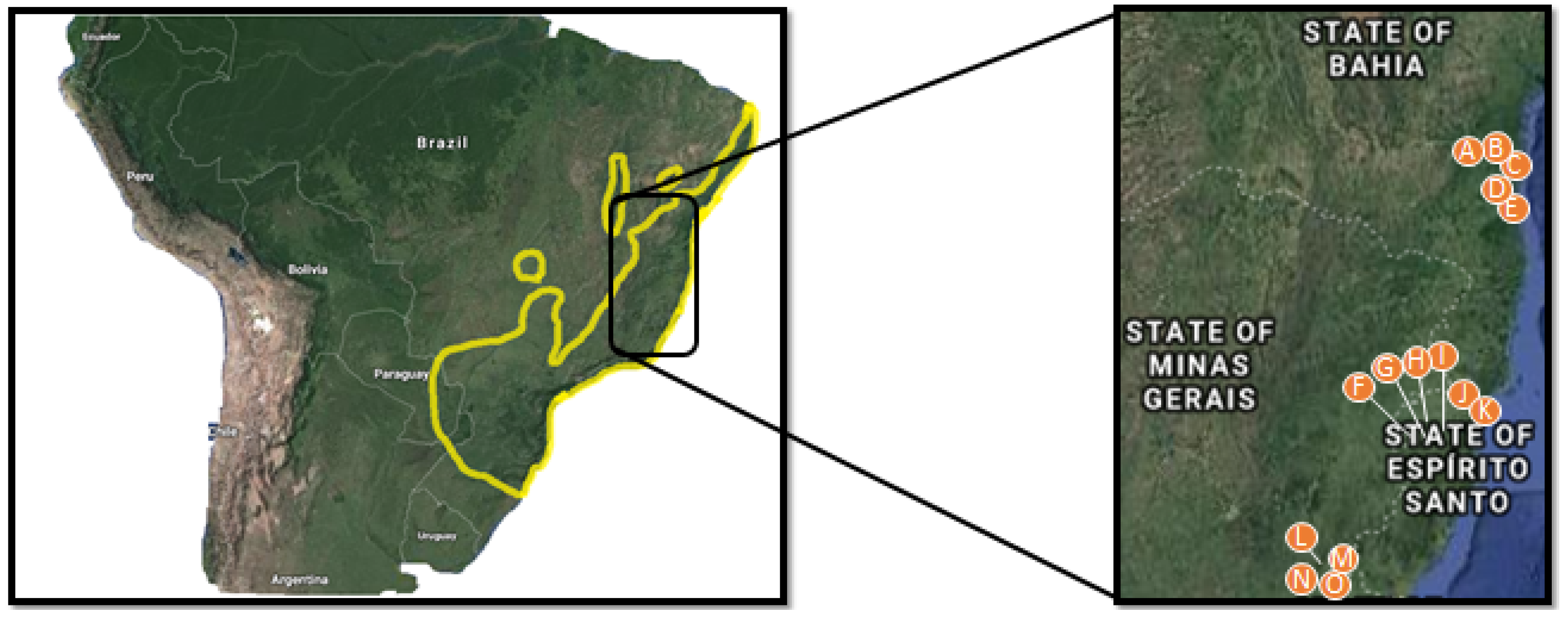
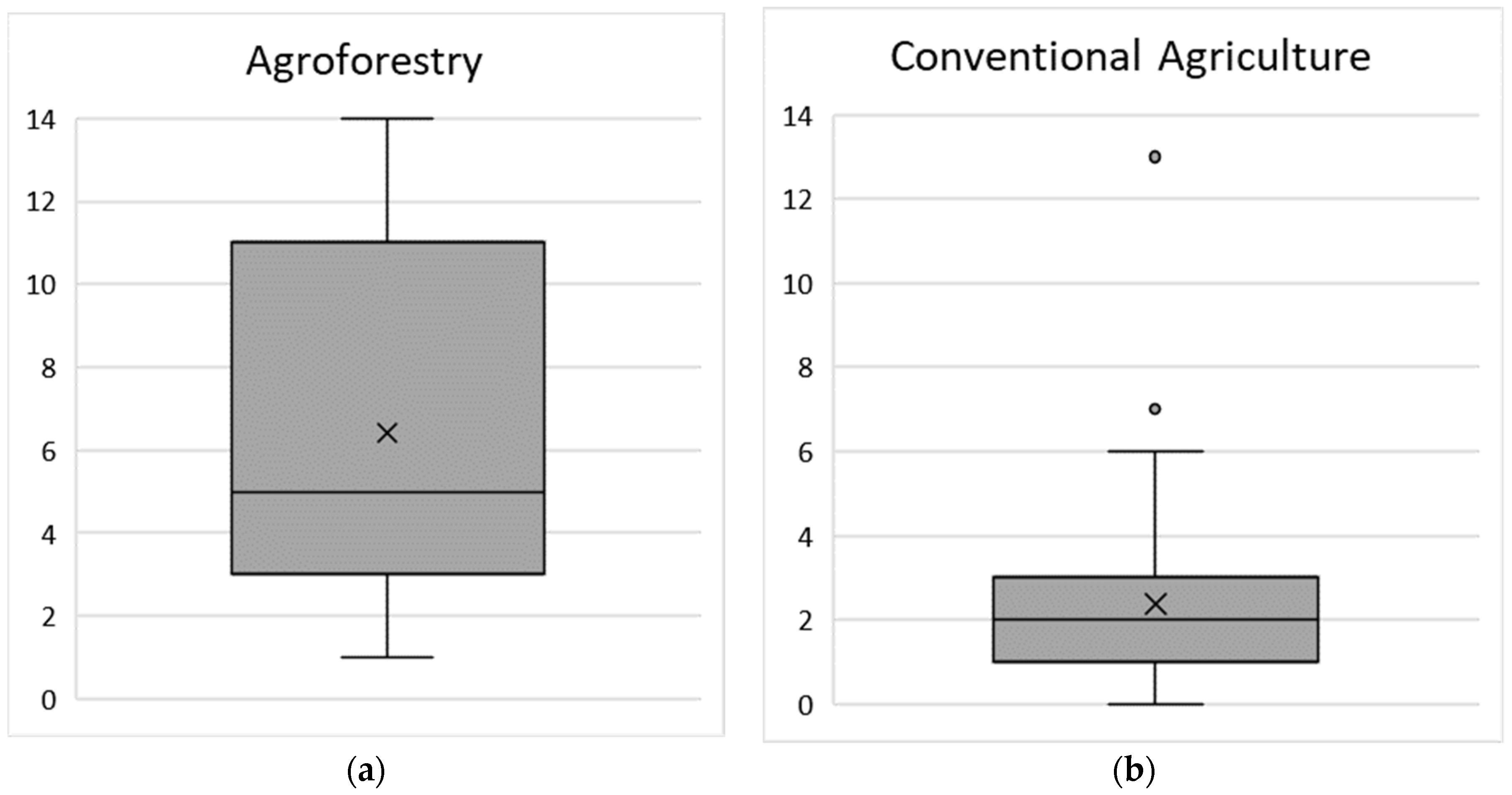
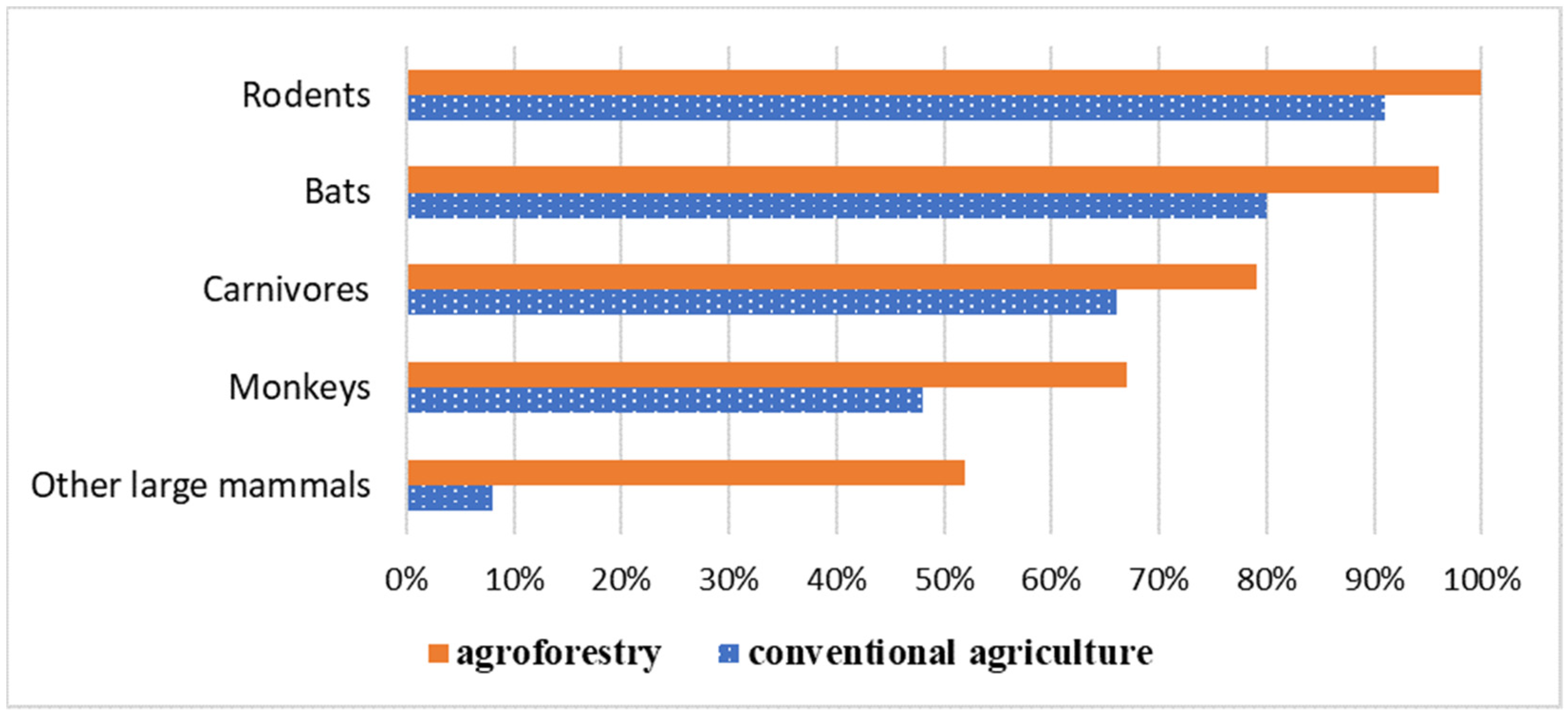
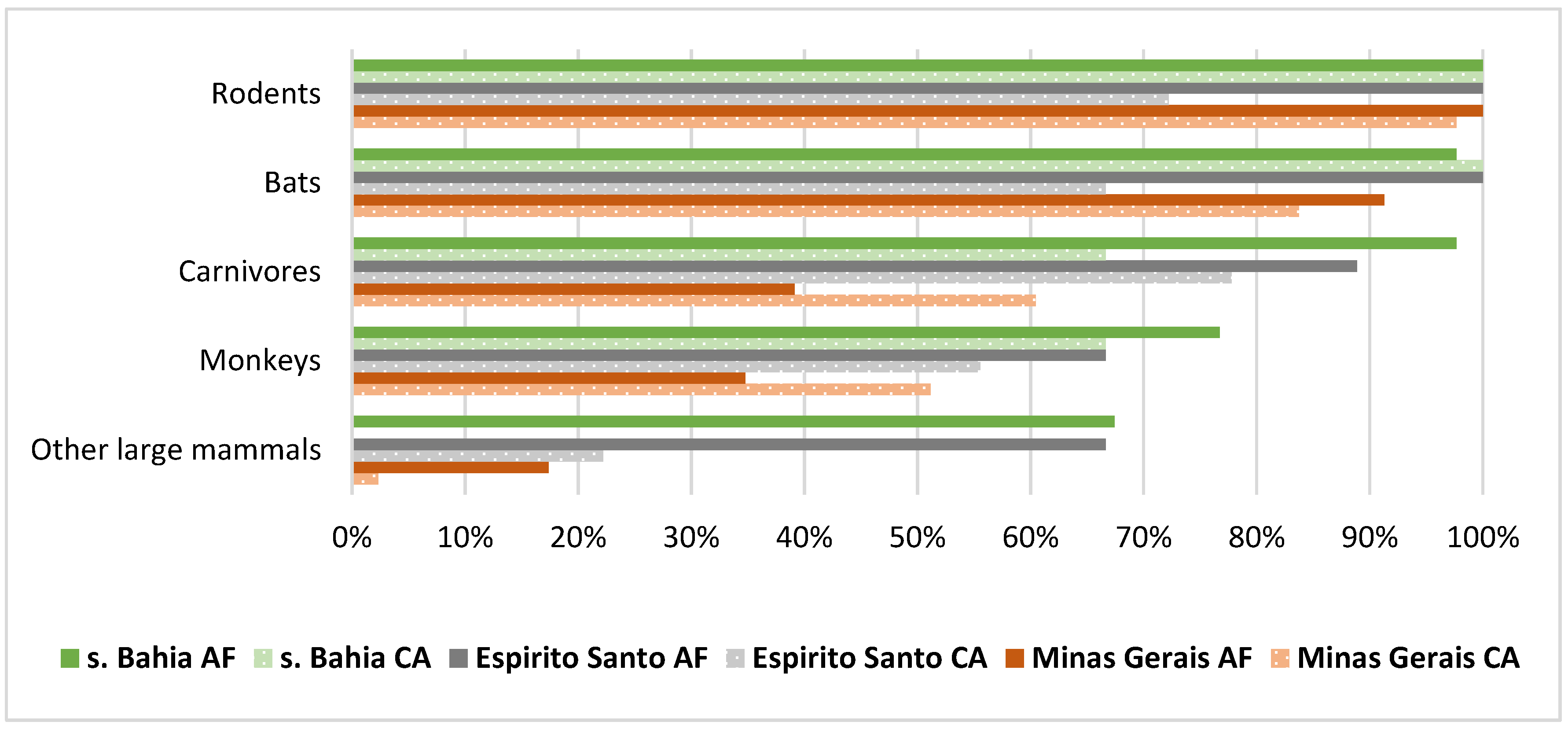
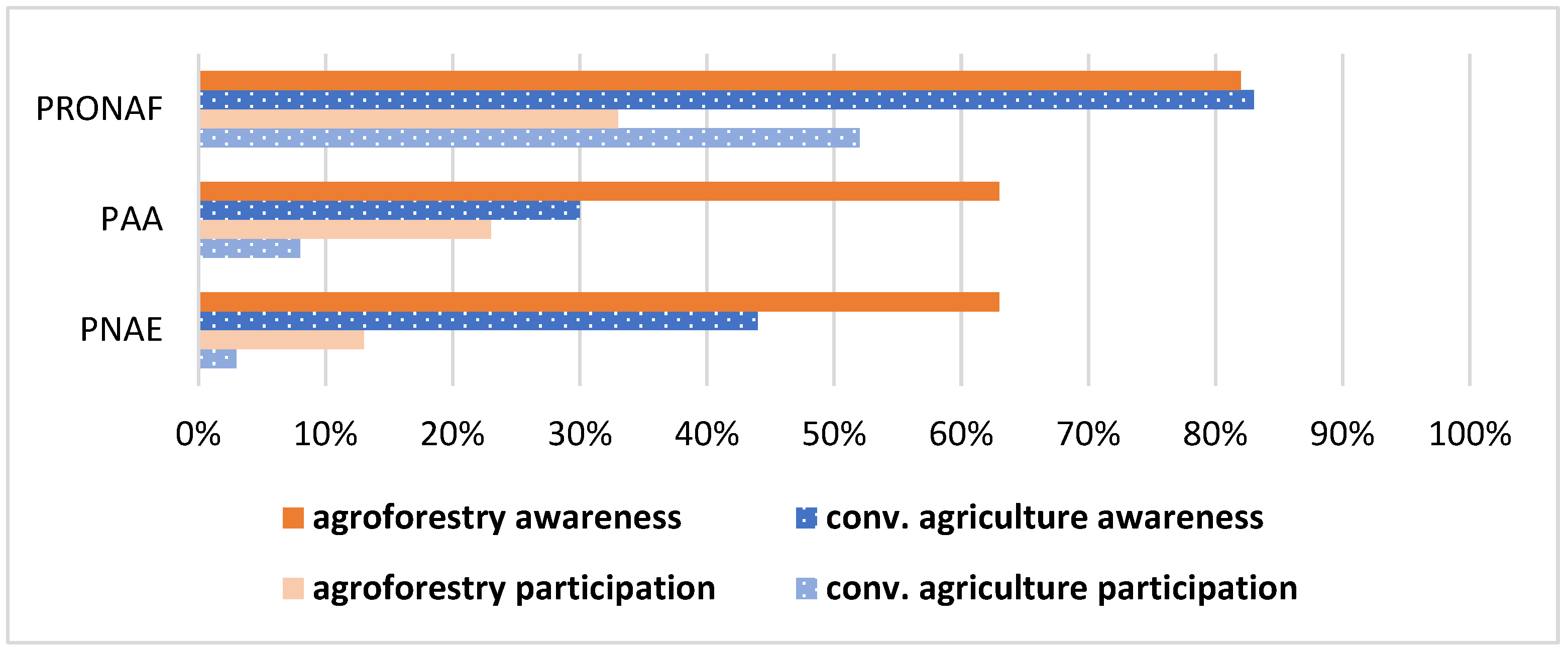
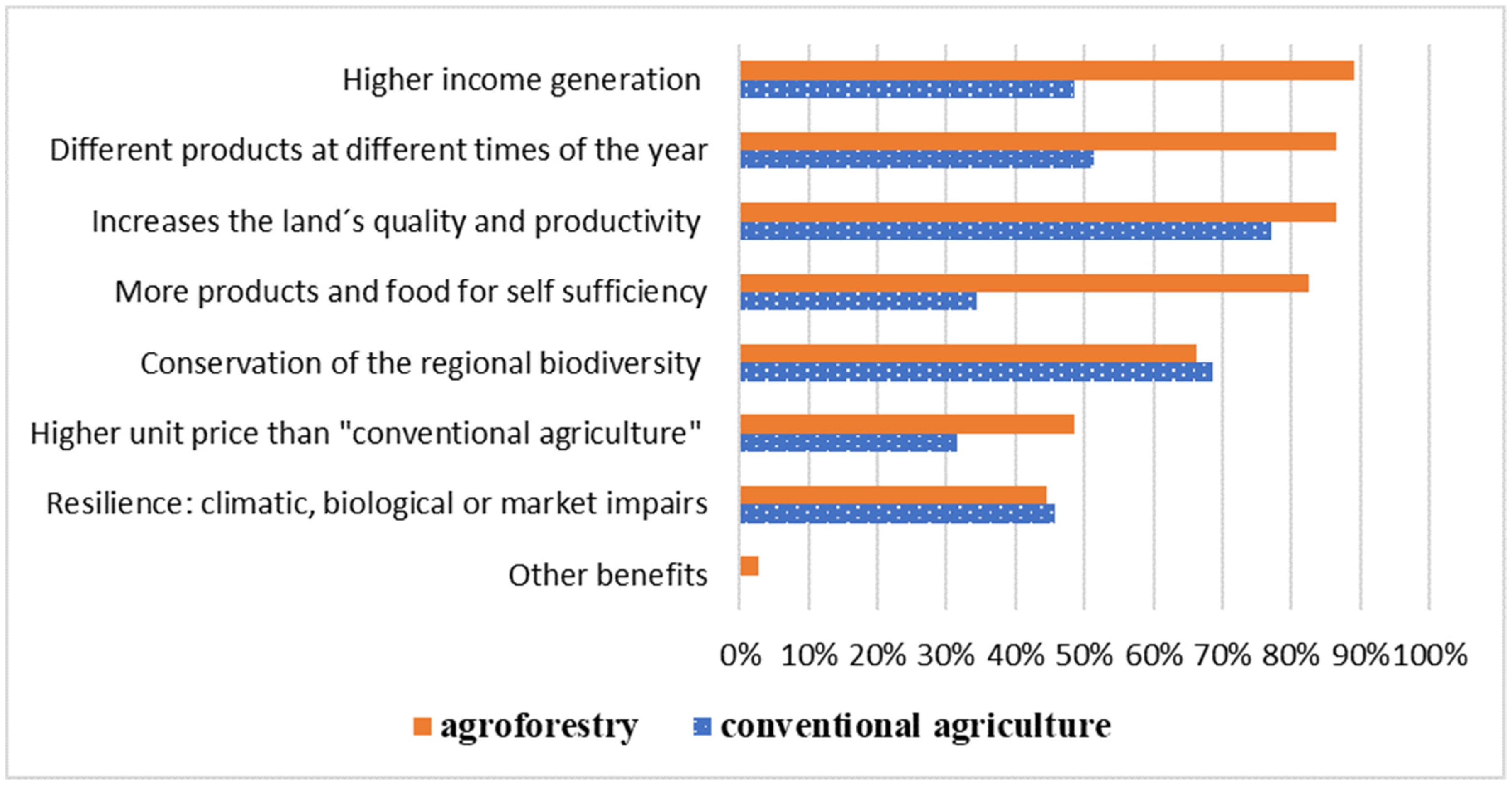
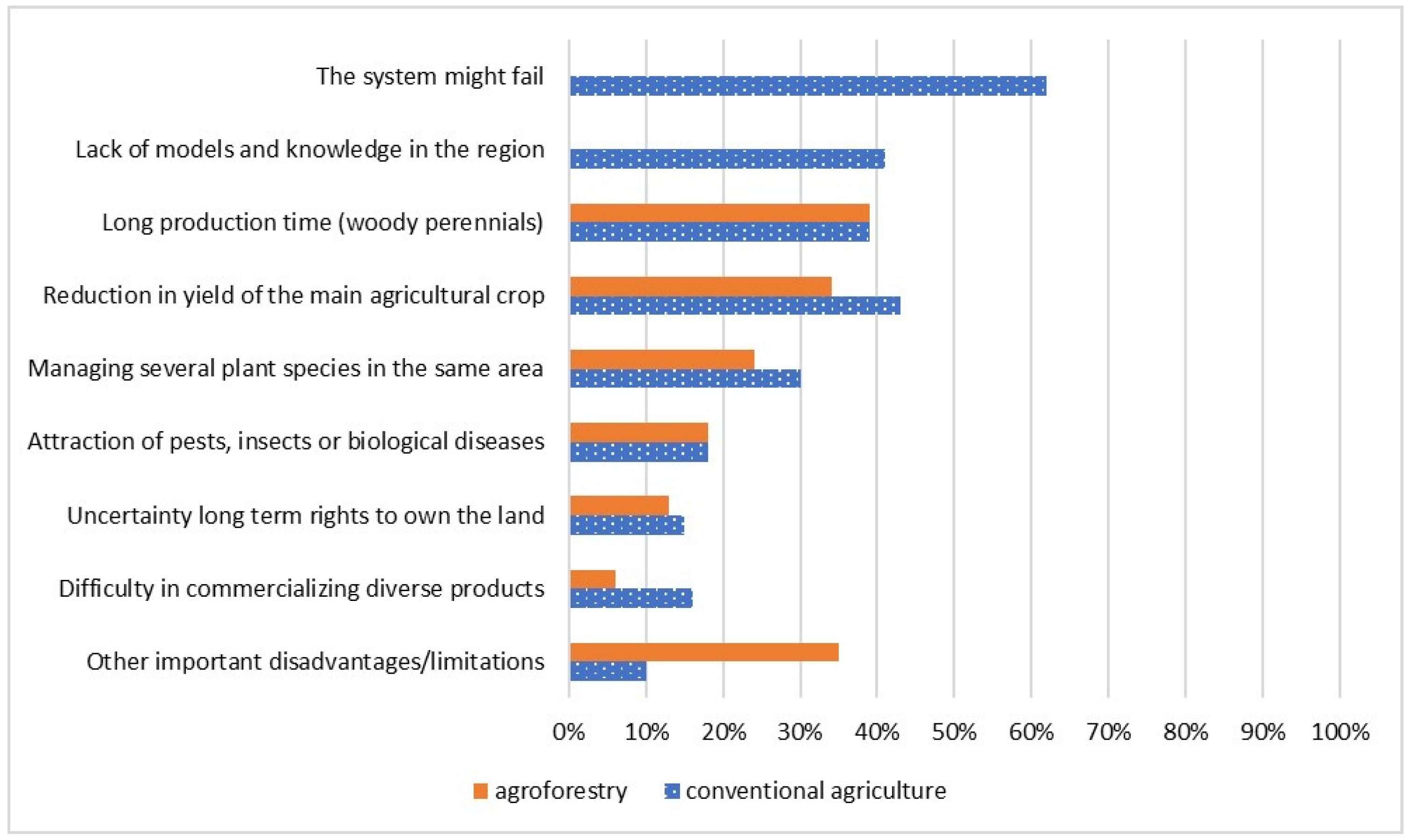
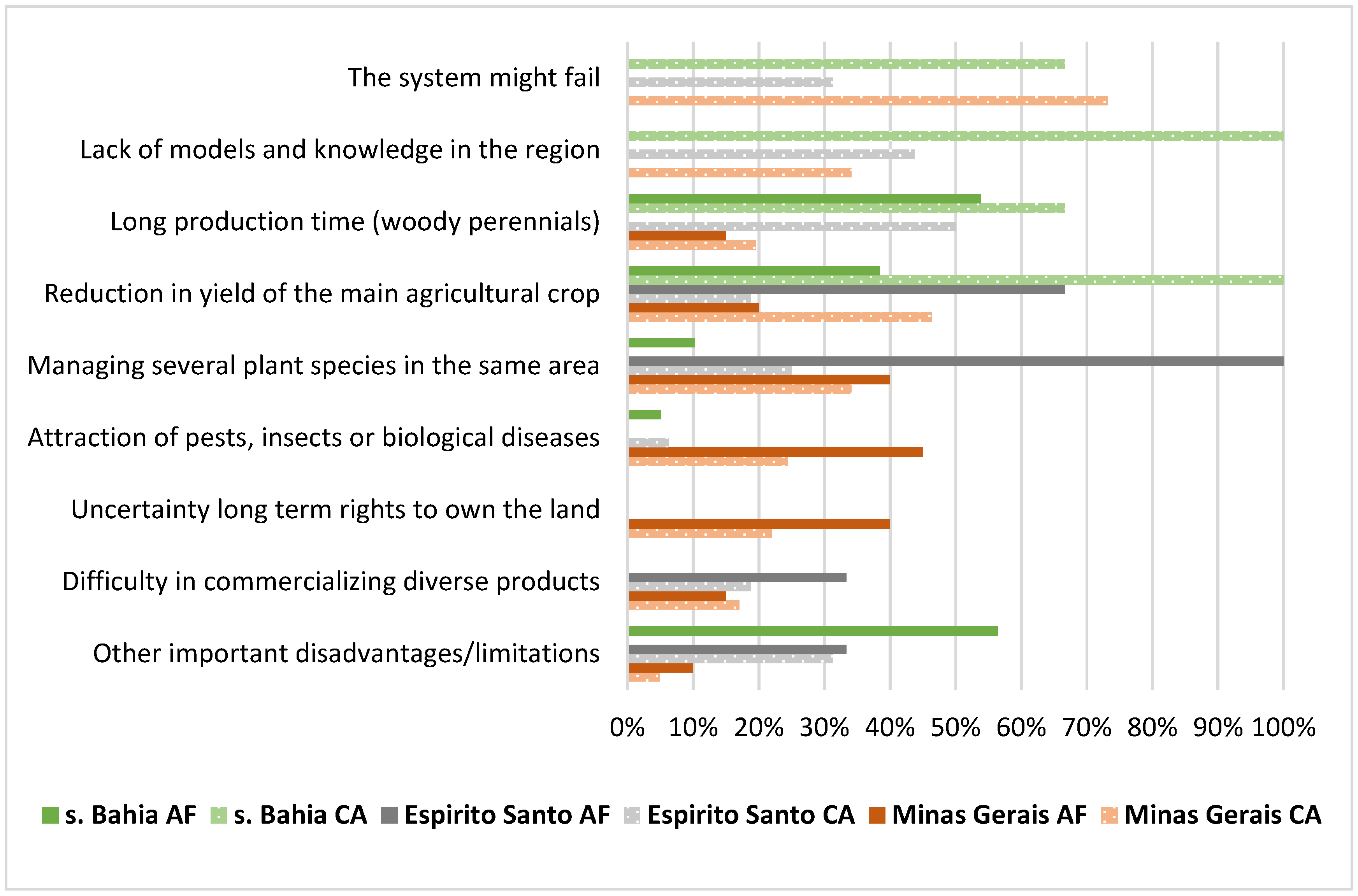

© 2019 by the authors. Licensee MDPI, Basel, Switzerland. This article is an open access article distributed under the terms and conditions of the Creative Commons Attribution (CC BY) license (http://creativecommons.org/licenses/by/4.0/).
Share and Cite
Sagastuy, M.; Krause, T. Agroforestry as a Biodiversity Conservation Tool in the Atlantic Forest? Motivations and Limitations for Small-Scale Farmers to Implement Agroforestry Systems in North-Eastern Brazil. Sustainability 2019, 11, 6932. https://doi.org/10.3390/su11246932
Sagastuy M, Krause T. Agroforestry as a Biodiversity Conservation Tool in the Atlantic Forest? Motivations and Limitations for Small-Scale Farmers to Implement Agroforestry Systems in North-Eastern Brazil. Sustainability. 2019; 11(24):6932. https://doi.org/10.3390/su11246932
Chicago/Turabian StyleSagastuy, Mauricio, and Torsten Krause. 2019. "Agroforestry as a Biodiversity Conservation Tool in the Atlantic Forest? Motivations and Limitations for Small-Scale Farmers to Implement Agroforestry Systems in North-Eastern Brazil" Sustainability 11, no. 24: 6932. https://doi.org/10.3390/su11246932
APA StyleSagastuy, M., & Krause, T. (2019). Agroforestry as a Biodiversity Conservation Tool in the Atlantic Forest? Motivations and Limitations for Small-Scale Farmers to Implement Agroforestry Systems in North-Eastern Brazil. Sustainability, 11(24), 6932. https://doi.org/10.3390/su11246932





